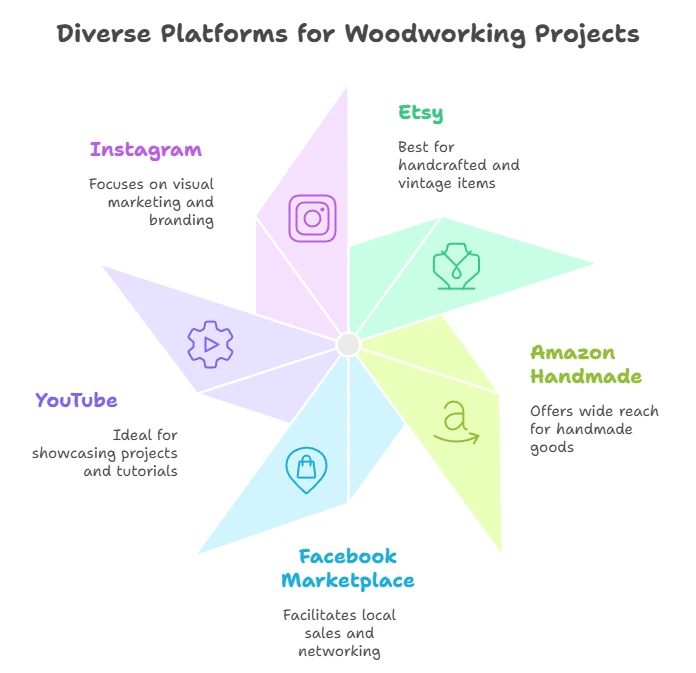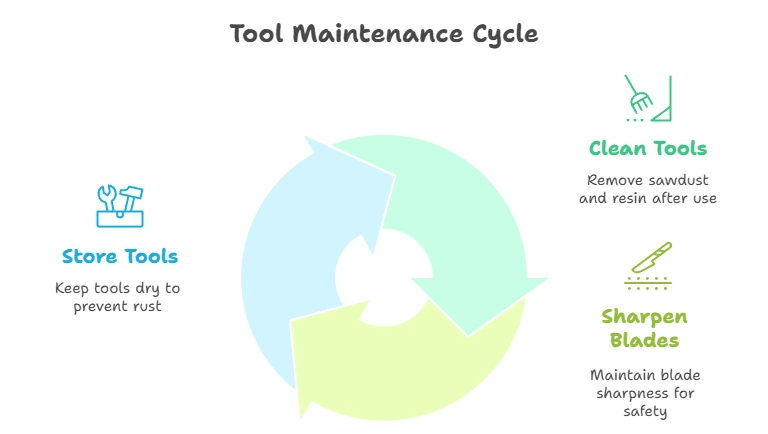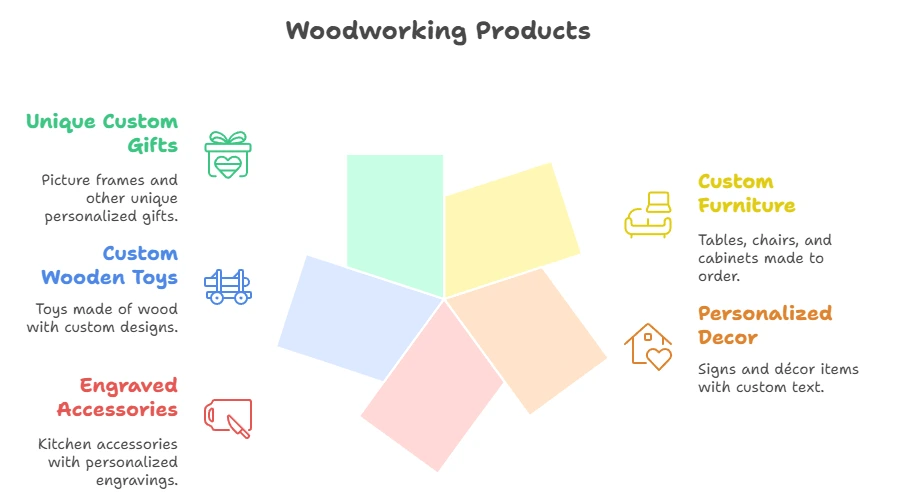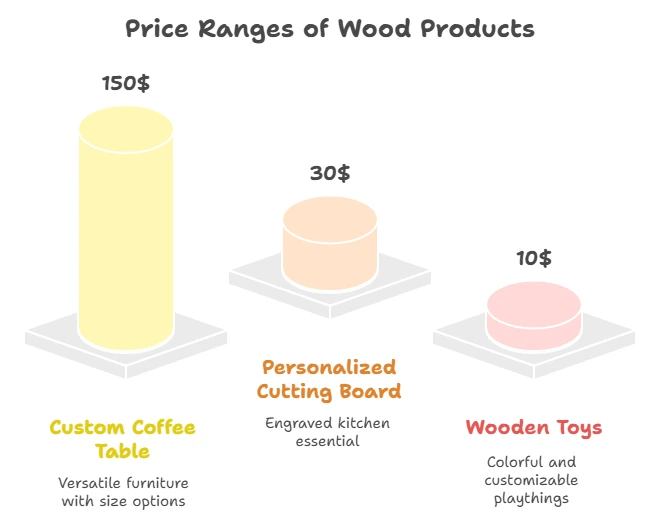
Woodworking can be a fulfilling hobby, and it can also transform into a profitable business venture. Whether you’re a novice or an expert in woodworking, there are numerous woodworking projects that sell well both online and offline. Let’s explore the types of projects you can create, how to sell them, and the best platforms to use.
Types of Woodworking Projects That Sell
Creating products that resonate with buyers is key to a successful woodworking business. Here are some popular woodworking projects that sell well:
- Furniture – Items like chairs, tables, and shelves are always in demand. Unique, handmade furniture pieces stand out in the market. Consider popular styles like rustic, modern, or farmhouse for different consumer preferences.
- Home Decor – Crafting decorative items such as wall art, picture frames, and wooden signs can attract buyers looking for personalized home accents.
- Outdoor Projects – Furniture for patios, garden planters, and birdhouses cater to gardening enthusiasts and homeowners looking to improve their outdoor space.
- Kitchen Items – Handmade cutting boards, utensil holders, and spice racks can be very appealing. Consumers appreciate quality kitchen tools made from durable materials.
- Toys and Games – Wooden toys are sought after by parents looking for safe, sustainable options. Consider making puzzles, building blocks, or traditional games.
Research Your Market
Understanding your audience is crucial. Research current trends in woodworking to identify what sells best. Platforms like Etsy and Amazon can provide insights into popular products and customer reviews. Additionally, visiting local craft fairs can help you gauge community interests.
Creating Quality Products
To ensure your woodworking projects that sell, focus on quality. Here are some tips to enhance your products:
- Materials: Use high-quality wood that offers durability and esthetic appeal. Hardwood like oak, maple, or walnut often commands higher prices.
- Finishing: A smooth finish with appropriate stains or paints can significantly increase the perceived value of your work.
- Design: Incorporate unique designs or customizations that display your creative touch.
Where to Sell Your Projects
There are numerous platforms to showcase your woodworking projects:
| Platform | Best For |
|---|---|
| Etsy | Handcrafted and vintage items |
| Amazon Handmade | Wide reach for handmade goods |
| Facebook Marketplace | Local sales and networking |
| YouTube | Showcasing projects and tutorials |
| Visual marketing and branding |

Marketing Your Woodworking Projects
Once you’ve created quality products, you need to market them effectively. Use social media platforms to share images of your projects. Creating engaging content like videos or behind-the-scenes posts can help build a loyal customer base. Consider participating in local craft fairs and farmers’ markets to meet potential customers face to face.
Pricing Your Projects
Setting the right price for your woodworking projects that sell is essential. Consider the cost of materials, time invested, and target market when determining prices. Research similar products to ensure you’re competitive but also ensuring your time and craftsmanship are valued.
With passion and dedication, woodworking can turn from a hobby into a profitable venture. By focusing on quality projects, understanding your market, and using the right platforms for marketing and sales, you can carve out a niche for yourself in the world of woodworking.
Essential Tools for a Successful Woodworking Business
Starting a woodworking business can be an exciting venture, but having the right tools is crucial for your success. Below are some of the essential tools that will help you create high-quality items for your customers while also boosting your productivity.
Essential Woodworking Hand Tools
Every woodworking shop should be equipped with a variety of hand tools. These tools allow for precision and detail in your projects. Here’s a list of must-have hand tools:
- Chisels: Used for precise carving and cutting.
- Hand Saws: Essential for making fine cuts in your wood pieces.
- Hammers: Both claw and mallet hammers serve different purposes in assembly.
- Screwdrivers: A set of Phillips and flathead screwdrivers is necessary.
- Measuring Tools: A tape measure and square are crucial for accuracy.
- Sandpaper: Varying grits help ensure smooth finishes on your projects.
Power Tools for Efficiency
Power tools can greatly enhance your efficiency and cut down on manual labor. Here are some essential power tools you should consider:
- Table Saw: Ideal for making long, straight cuts on plywood and other large sheets.
- Router: Perfect for decorative edges and hollowing out areas.
- Jigsaw: Great for cutting curves and intricate designs.
- Bandsaw: Excellent for resawing and cutting irregular shapes.
- Drill Press: Provides precision when drilling holes in your materials.
Woodworking Accessories
In addition to your primary tools, having the right accessories can optimize your woodworking process:
- Workbenches: A robust workbench provides a stable surface to work on.
- Clamps: They hold pieces together while your glue dries or for stability during cuts.
- Safety Gear: Always prioritize safety with goggles, ear protection, and dust masks.
- Tool Storage: Organizers help you keep your workspace tidy and safe.
Investing in Quality Tools
Investing in quality tools is a long-term benefit. While it may be tempting to go for cheaper options, higher-quality tools often yield better results. These tools tend to last longer, perform better, and help you achieve higher-quality finishes. Consider reputable brands known for their durability and performance.
Maintaining Your Tools

To ensure longevity and consistent performance, maintenance is key. Here are some tips for keeping your tools in excellent condition:
- Regular Cleaning: Clean tools after every use to remove sawdust and resin.
- Sharpen Blades: Dull blades can hinder performance and can be unsafe.
- Storage Solutions: Keep tools in a dry place to avoid rust and wear.
Many woodworking enthusiasts and professionals find that with the right tools and care, they can create beautiful, sellable products. Discover unique woodworking projects that can boost your income by visiting Wood Magazine or check out creative ideas at Ana White.
Your woodworking business will thrive with the right tools and a commitment to quality. Remember that every successful project begins with proper preparation and the right equipment. Keeping an updated inventory, maintaining your tools, and exploring new designs and techniques will help keep your business flourishing.
| Type of Tool | Purpose |
|---|---|
| Chisels | Carving and cutting |
| Table Saw | Making long, straight cuts |
| Router | Decorative edges and hollowing out |
| Drill Press | Precision drilling |
Leverage these tools and tips to maximize your woodworking potential. Your craftsmanship paired with the right equipment will set the stage for a successful and profitable woodworking business.
Trends in Custom Wood Products for Increased Sales
Creating custom wood products is not only a passion for many but also a viable business opportunity. Understanding the trends in woodworking can significantly boost your sales. Whether you are a seasoned woodworker or just starting out, staying updated on the current market demands is essential.
One of the main trends gaining traction is sustainability. Consumers are increasingly leaning towards eco-friendly products made from reclaimed or sustainably sourced wood. By promoting your use of such materials, you attract environmentally-conscious buyers. Highlighting the sustainability aspect can differentiate your products in a crowded marketplace.
Offer Personalization

Another important trend is personalization. Customers love unique items that reflect their style. Offering customizable options allows buyers to tailor products to their specifications. Here are some popular custom wood products that you can offer:
- Custom furniture (tables, chairs, cabinets)
- Personalized signs and home décor
- Engraved kitchen accessories (cutting boards, utensils)
- Wooden toys with custom designs
- Unique gifts, like custom picture frames
Technology
Technology is also playing a significant role in woodworking. CNC machines, laser cutters, and 3D printers are becoming more accessible. These technologies allow you to create intricate designs that were once difficult to achieve by hand. Implementing these tools can enhance the quality and precision of your products.
Social Media Role
Social media is another critical aspect of modern sales. Platforms like Instagram and Pinterest are perfect for showcasing visually appealing wood products. By consistently posting high-quality images and engaging with your audience, you can create a loyal customer base. Let’s delve into how to effectively use social media:
- Post regularly to keep your audience engaged.
- Use hashtags relevant to woodworking and home decor.
- Share behind-the-scenes content to connect on a personal level.
- Encourage customer interaction by asking for feedback.
Multifunctional Furniture
Additionally, consider the growing trend of multifunctional furniture. As living spaces decrease in size, products that serve multiple purposes are increasingly popular. Items like sofa beds, storage ottomans, and expandable tables cater to customers looking for practical solutions without compromising style.
The rise of online shopping
The rise of online shopping opens new avenues for selling woodworking projects that sell. Building a user-friendly website is vital. You can feature an online shop with clear images and descriptions. Make sure to optimize your site for SEO to enhance visibility. It’s beneficial to include a blog that provides tips and insights about woodworking. This not only positions you as an expert in the field but can also drive traffic to your website.
Collaborating with influencers
Consider collaborating with influencers who resonate with your brand. Partnering with home décor and lifestyle bloggers can help your products reach a broader audience. They can showcase how your custom wood products fit into their lives, ultimately driving sales.
Pricing your products competitively
Pricing your products competitively is crucial in an oversaturated market. Research similar products and understand what customers are willing to pay. Offering tiered pricing for various customization levels can also attract a range of buyers.
| Wood Product | Average Price Range | Customization Options |
|---|---|---|
| Custom Coffee Table | $150 – $800 | Size, wood type, finish |
| Personalized Cutting Board | $30 – $100 | Engraving, size |
| Wooden Toys | $10 – $50 | Color, size, name engraving |

To maximize your reach, consider selling on established platforms such as Etsy or Shopify. These sites cater to customers looking specifically for unique and handmade items, making them ideal for your custom wood products.
Staying on top of woodworking trends is key to boosting your sales. By focusing on sustainability, personalization, and effective use of technology and social media, you can position your custom wood projects for increased sales and sustained success in your woodworking business.
Tips for Pricing Your Woodworking Projects Competitively
When you’re ready to sell your woodworking projects that sell, one of the most challenging aspects can be deciding how to price them competitively. Proper pricing not only helps to ensure you cover your costs and earn a profit, but it also positions your products well in the market. Here are some essential tips to guide you in setting competitive prices.
Understand Your Costs
The first step to pricing your woodworking projects is to calculate your total costs accurately. Here are the main components to consider:
- Materials: Calculate the cost of all wood, screws, paint, and finishes.
- Labor: Determine how much you want to pay yourself per hour and estimate the total hours spent on each project.
- Overhead: Factor in costs related to tools, shop space, utilities, and marketing.
- Shipping: Include costs for packaging and delivery if applicable.
Research Your Market
To determine a competitive pricing strategy, you need to understand the market for your woodworking projects that sell. Start with these steps:
- Competitor Analysis: Look at similar products offered by competitors. Pay attention to their pricing, materials used, and overall quality.
- Target Audience: Identify who your ideal customers are and what they are willing to pay for similar items.
- Market Trends: Stay informed about woodworking trends by visiting sites like Woodworkers Source to see what’s popular.
Choose Your Pricing Model
Decide which pricing model works best for your products. Consider these options:
- Cost-Plus Pricing: Add a markup percentage to your total costs (materials, labor, and overhead).
- Market-Based Pricing: Set prices based on what the market dictates, adjusting for your unique value proposition.
- Competitive Pricing: Align your prices closely with your competitors while considering quality and uniqueness.
Highlight Your Unique Selling Proposition (USP)
Every project has something that makes it special. Highlight what sets your woodworking projects that sell apart. Focus on your craftsmanship, the quality of materials, or unique designs. Showcase these aspects in your marketing to justify your pricing strategy.
Create Pricing Tiers
Having different pricing tiers can attract a broader audience. Consider offering:
- Basic Projects: Simple, cost-effective items that can cater to budget-conscious customers.
- Mid-Range Options: A balance between affordability and craftsmanship, appealing to a wider audience.
- High-End Products: Premium pieces made of rare woods or featuring exceptional craftsmanship for discerning customers.
Test and Adjust Your Prices
Once you set your initial prices, don’t hesitate to test them out. Monitor sales and customer feedback closely. If a particular product is not selling well, consider adjusting your pricing. You may also find that seasonal trends affect pricing, so be flexible to make adjustments throughout the year.
Use Online Platforms for Pricing Insights
Websites like Etsy and Amazon can give you valuable insights into how your projects are priced relative to similar items. Browse through categories similar to your woodworking projects that sell, and note pricing strategies and customer responses. This can help you modify your pricing to better suit the market.
Engage with Customers
Your existing customers can provide invaluable feedback on pricing. Engage with them through social media, email newsletters, and in-person at craft fairs. Ask them about their buying habits and how much they would value different aspects of your work. This can help you make informed pricing decisions.
In the end, effective pricing is about finding the balance between what your customers are willing to pay, the value you provide, and what it takes for you to run a profitable woodworking business. Stay informed, be open to adjustments, and keep your unique strengths in focus.
Marketing Strategies for Selling Your Woodworking Creations
Marketing your woodworking creations can seem daunting, but with the right strategies, you can effectively sell your projects and reach a wider audience. Whether you are a hobbyist or a professional, understanding how to showcase your products is essential for success.
Leveraging Social Media
One effective way to market your woodworking projects that sell is through social media platforms. Sites like Instagram and Facebook allow you to create visually appealing content that showcases your work. Use high-quality images of your finished projects and share behind-the-scenes looks at your woodworking process. Engaging with your audience by responding to comments and sharing your story can help to build a loyal customer base.
Building an Online Presence
You might also consider creating a dedicated website to showcase your work. Having your own online space allows you to present your projects in a professional manner. You can include a portfolio gallery, descriptions of each item, and a blog that shares woodworking tips and techniques. This not only positions you as an expert but also makes it easier for potential customers to find you. Websites like Etsy or Shopify can also help you set up an online shop quickly and efficiently.
Utilizing Online Marketplaces
Utilizing online marketplaces can also boost your sales. Platforms such as Amazon Handmade or eBay allow you to tap into a larger audience who are actively looking to purchase unique woodworking items. Be sure to optimize your product listings with clear descriptions and relevant keywords like “handmade furniture,” “custom wood products,” or “unique decor.” This helps in being discovered by potential buyers through search engines.
Participating in Local Events
Participating in local craft fairs, markets, or woodworking shows can significantly increase your visibility. Not only can you sell your products directly, but you also get the chance to interact with potential customers face-to-face. Being present at these events allows you to showcase the quality of your work and develop relationships with your community. Prepare business cards to hand out so interested individuals can easily find you after the event.
Collaborating with Influencers
Collaborating with influencers in the woodworking or DIY space can also be an effective marketing strategy. Look for social media influencers who share a similar audience and propose a partnership where they showcase your creations in exchange for free products or commissions. This can enhance your visibility and provide credibility to your brand.
Offering Promotions and Discounts
Offering discounts or promotions can attract new customers to your woodworking products. Consider seasonal sales, bulk purchase discounts, or limited-time offers. Marking special occasions like holidays can create urgency and encourage people to buy. Make it easy for customers to take advantage of these deals through clear promotions on your website and social media profiles.
Engaging with Customers for Loyalty
Engaging with customers after their purchase is crucial. Follow-up emails thanking them for their business can cultivate loyalty. You can also request feedback or reviews, which not only helps improve your service but also builds trust with future customers. Display positive reviews prominently on your website and social media pages to enhance credibility.
Recap of Marketing Strategies

A focused approach allows you to effectively market your woodworking creations. Here’s a recap of strategies to consider:
- Utilize social media to showcase your work.
- Create a professional website or use online marketplaces.
- Participate in local craft fairs and markets.
- Collaborate with influencers for greater reach.
- Implement promotions and discounts.
- Engage with customers through follow-ups and feedback requests.